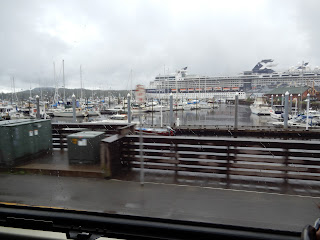Lifeboats, Lumberjacks, and Totem Poles
Our last port of call before the conclusion of our cruise was Ketchikan, Alaska, the fourth largest city in the state with about 14,000 residents. It is located on the southwestern end of Revillegigedo Island in the Tongass Rainforest. Its picturesque landscape was vintage Alaska.
The climate is oceanic, classified as similar to Scotland or Northern Ireland with temperatures averaging between 40 to 50 degrees F for the year. The record low is - 1 degrees F and the record high is 89 degrees F, which is more temperate than the climate in my state of Nebraska! https://en.wikipedia.org/wiki/Ketchikan,_Alaska. It is also a very wet climate with a large amount of precipitation recorded each year.
The downtown is located on the waterfront and is built on pilings. A few blocks away from the waterfront is famous Creek Street, where the town's once thriving red light district was located. Today this street can be explored by boardwalk with many of its original houses of ill repute still standing and transformed into cafes, shops, and bars.
To reach shore for our excursions, we couldn't walk the gangway from the ship as in previous ports because there were too many cruise ships scheduled to dock simultaneously. Instead, we were required to disembark the MS Zaandam by using the ship's tenders, or lifeboats. First we watched the lifeboats being lowered from the hull to the ocean surface.
Then we were divided into groups of about 40 people to board the lifeboats for transfer to shore. Some of us had room to sit on rough benches, while others had to stand for the 10-minute ride to the dock. We were close enough to ocean water to feel the spray on our faces. Once we reached the dock, we loaded onto a bus for our excursion to Saxman Village, a very small town about 2 miles from Ketchikan where the residents are from the First Nation of the Tlingit. The name of the tribe is pronounced by English speakers as "Klingit". Here community members had built a community center with meeting rooms where we viewed a video presentation about the history and culture of the Tlingits and viewed some of the craft items created and sold by the tribe.
We were told that the early Tlingits had shared a lodge similar to this, where each family was assigned a particular space on the floor of the lodge for their own members. The lodge contained wooden benches for the visitors to sit facing the wooden stage.
At the end of the dance, members of the audience were invited to come to the stage, don Tlingit dress, and participate in the dance. Next we moved to the Carvers' Lodge, a separate building where a master carver works to create totem poles. He explained that he often makes the poles on commission; depending on the size and intricacy of the totems, he may charge up to $4,000 each.
Last, we walked outside of the lodge to see several standing totem poles and to hear an explanation of their meaning. Later, we learned that the totem on this site and at another nearby totem park had been moved from various abandoned villages in the area in the 1930's by workers in the Civil Conservation Corps (CCC), one of the programs created by FDR to provide jobs during the New Deal. The CCC then hired native carvers to restore the deteriorating totems to their former condition.
The audience sat in bleachers while the actors playing the role of lumberjacks demonstrated skills of log sawing, carving, tree climbing, and log rolling, while a woman pretending to be part of the lumberjack company, narrated the event with a dash of humor. The last event saw both men dunked in the water as they competed to force each other off the log. To access more information and watch videos of the show, see the following website: https://alaskanlumberjackshow.com. / We enjoyed the atmosphere of the town square for a bit before returning to our ship for dinner.



























Comments
Post a Comment